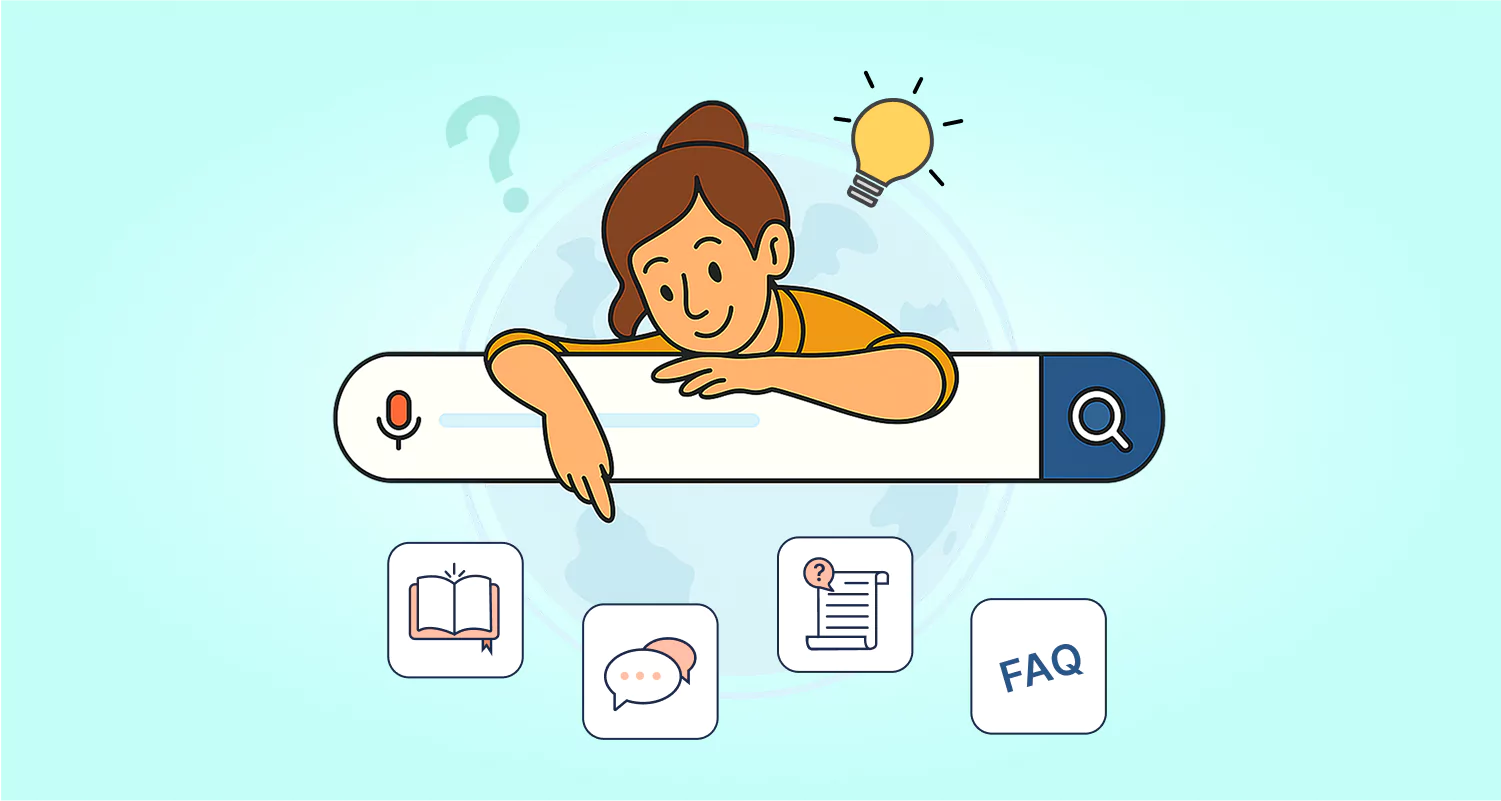It’s tempting to believe your customer service approach is flawless. After all, you’ve dedicated hours to training your team and designing workflows that seem to keep customers happy.
According to Tony Hsieh, former CEO of Zappos, “Customer service shouldn’t just be a department, it should be the entire company.”
But even the slickest systems can hide sneaky weaknesses. A customer service audit is your opportunity to step back and evaluate every aspect of your support operations.
By making service audits a regular habit, you can step back, size up your operations with a clear lens, and confirm you’re delivering the exceptional experience your customers crave.
This article covers the key components, benefits, and best practices for conducting an effective customer service audit.
What is a customer service audit?
A customer service audit is a comprehensive evaluation of your organization’s customer support operations, aimed at improving the quality and consistency of service delivery.
This service audit process involves:
- Analyzing customer interactions across all communication channels.
- Reviewing tools and workflows used by your support team.
- Gathering and interpreting customer feedback.
- Assessing team performance and efficiency.
- Evaluating the accuracy and usefulness of your knowledge base.
The primary goal of carrying out regular customer service audits is to identify both strengths and areas for improvement.
By doing so, you ensure your customer service strategy always aligns with the business objectives and adapts to evolving customer needs.
Why make customer service audits a habit?
A customer service audit requires time and dedication, but it is extremely beneficial, especially when conducted regularly. Here are several compelling reasons to prioritize this process:
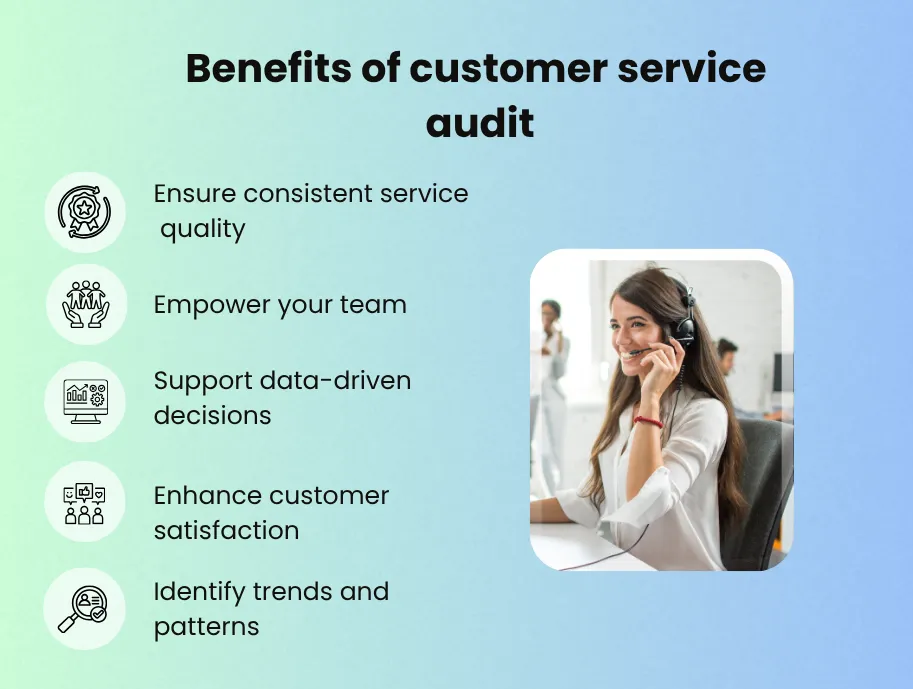
- Ensure consistent service quality: When you perform regular audits, you can catch deviations or pain points early and address them before they affect the quality of support and overall customer satisfaction.
- Empower your team: Audits provide valuable feedback to customer service teams, highlighting both their strengths and areas they need to improve in their support offerings. This boosts motivation and helps tailor training programs effectively.
- Support data-driven decisions: Conducting routine customer service audits helps generate valuable insights that can inform decisions about support team staffing, training, technology investments, and customer engagement strategies.
- Enhance customer satisfaction: Happy customers spend more and refer others—by regularly auditing and improving your service delivery, you create better experiences that drive satisfaction and business growth.
- Identify trends and patterns: Through auditing customer service, you can identify recurring problems, emerging customer needs, or shifts in their expectations. This insight helps you remain proactive instead of reactive.
How to conduct an effective customer service audit
Carrying out a customer service audit is a vital step toward delivering consistent, high-quality support.
It ensures your team is aligned with customer expectations and helps maintain service excellence as your business grows. Every business is different, but the most successful customer service audits follow these common steps:
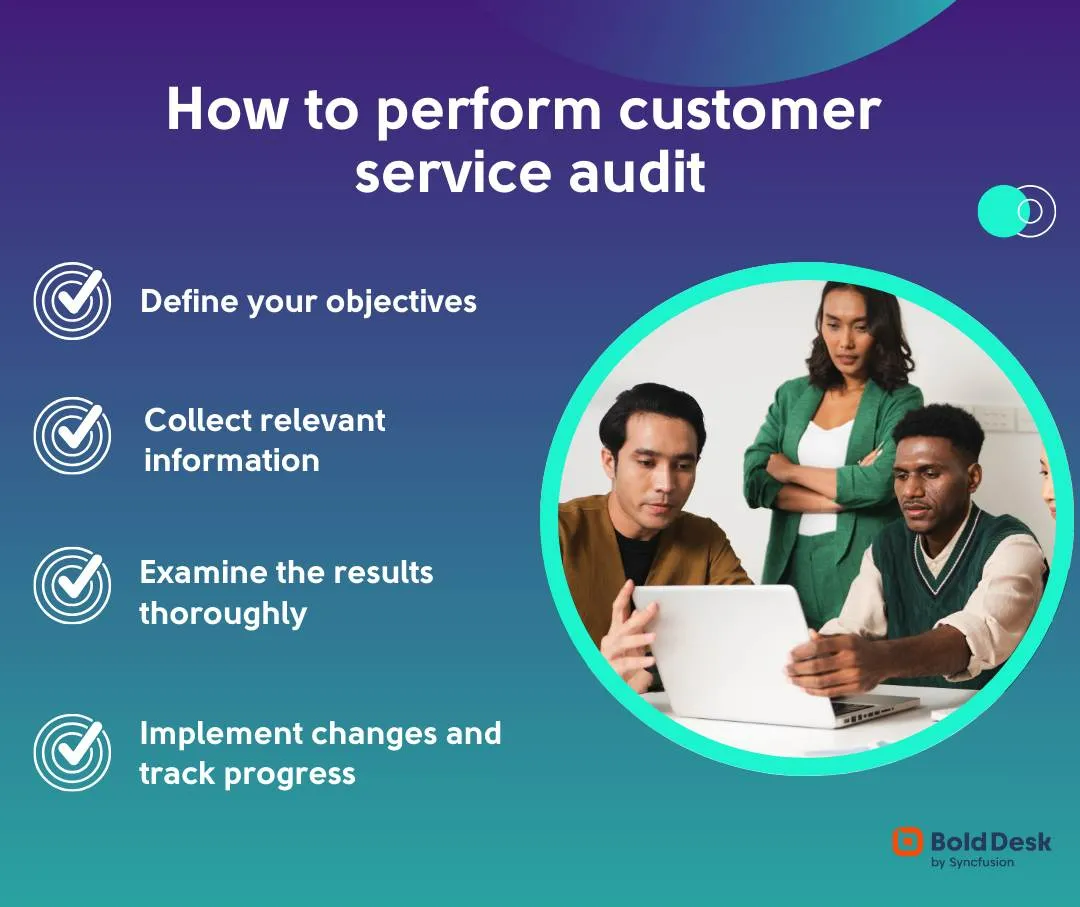
Define your objectives
Every successful journey begins with a clear destination. The same applies to a customer service audit.
What are your audit goals? Begin your audit by identifying what you want to achieve. Defining specific focus areas will help keep your evaluation targeted and aligned with both support and business objectives.
Ask yourself these questions when setting your customer support audit goals:
- What aspects of customer service need improvement?
- Which metrics or outcomes are we aiming to influence?
- How will success be measured?
Pro-tip: The answers to these questions will help you know the main agenda for your audit and will guide you throughout the process. Be very specific and sure of your endgame.
Collect relevant information
To evaluate your customer service performance effectively, gather insights from multiple sources. A well-rounded audit draws on both quantitative and qualitative data.
To evaluate your customer service effectively, start by collecting a mix of customer feedback, such as survey responses and reviews, along with support data like issue volume, resolution times, and common trends.
Pro-tip: Ensure the data covers a representative time period and includes all communication channels. The more complete your data, the clearer your picture of your current service quality and the easier it is to identify what needs improvement.
Examine the insights thoroughly for strategic growth
To drive high-impact growth, thoroughly assess your data to uncover insights into your customer service performance.
- Which issues most significantly impact customer experience?
- What improvements align with your business goals and available resources?
- Which changes are feasible based on effort and potential return?
Pro-tips: Focus on analyzing patterns in response and resolution times to gauge support efficiency and customer satisfaction trends. You can also review feedback, both complaints and compliments, to identify your support strengths and high-impact areas for improvement.
Implement changes and track progress
Auditing customer service is only valuable if it leads to meaningful action. How can you ensure your service audit strategies are a success?
According to Peter Drucker, renowned management consultant and author, “You can’t improve what you don’t measure.”
Here’s how to turn insights into impact:
- Set deadlines, assign tasks, and decide what needs to change (e.g., training, tools, scripts).
- Communicate changes clearly and empower your team to act.
- Track requests, agent performance, and trends in real time using tools like BoldDesk’s reports and analytics dashboards.
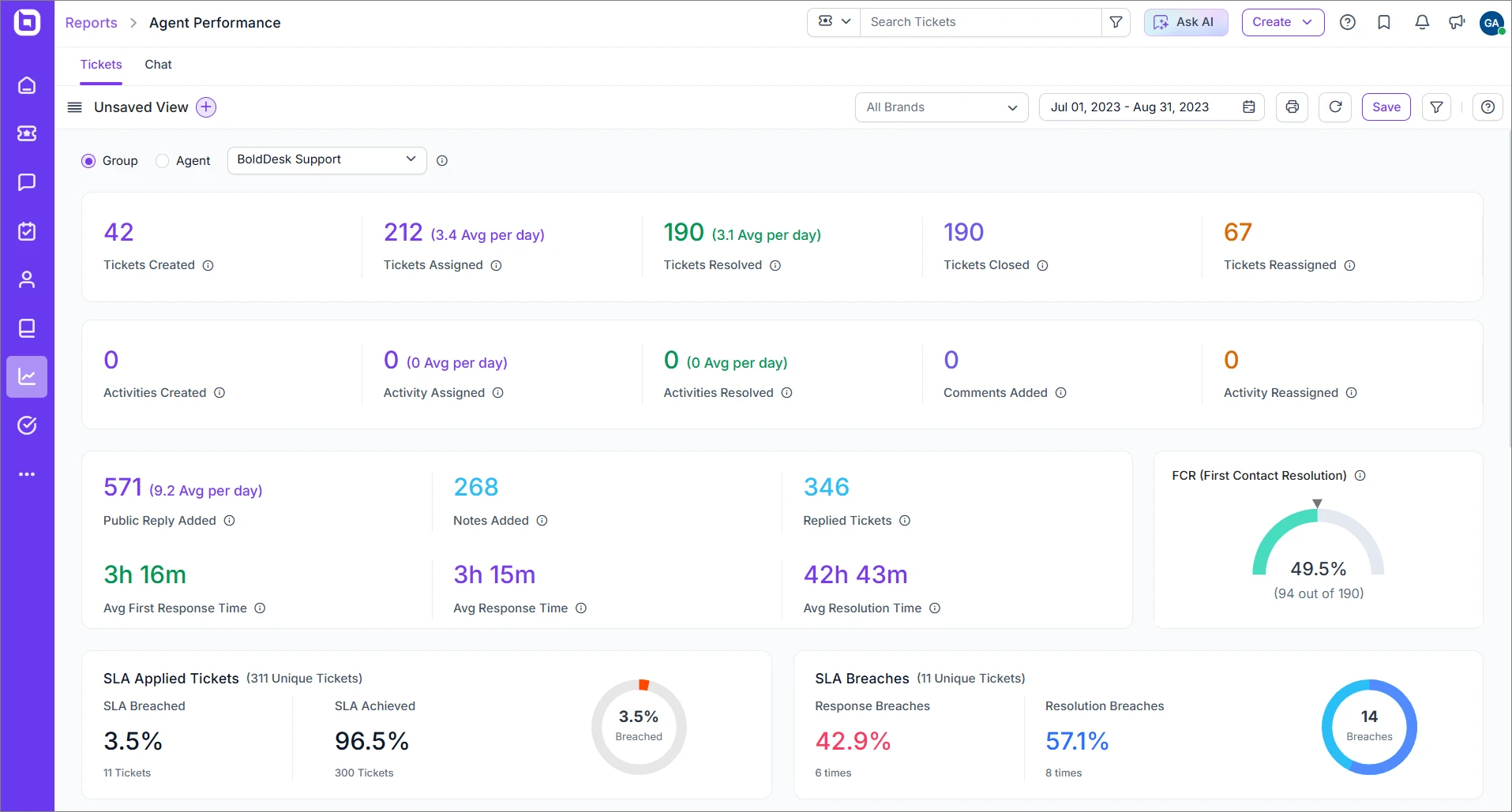
Customer service audit checklist
Having a structured checklist ensures your customer service audit templates is thorough and everyone involved aligns with the main goal for doing it in the first place.
Here is an example of a customer service audit checklist you can use to evaluate and improve your customer support processes.
You can check off each item as completed, as you review your team’s performance and support systems.
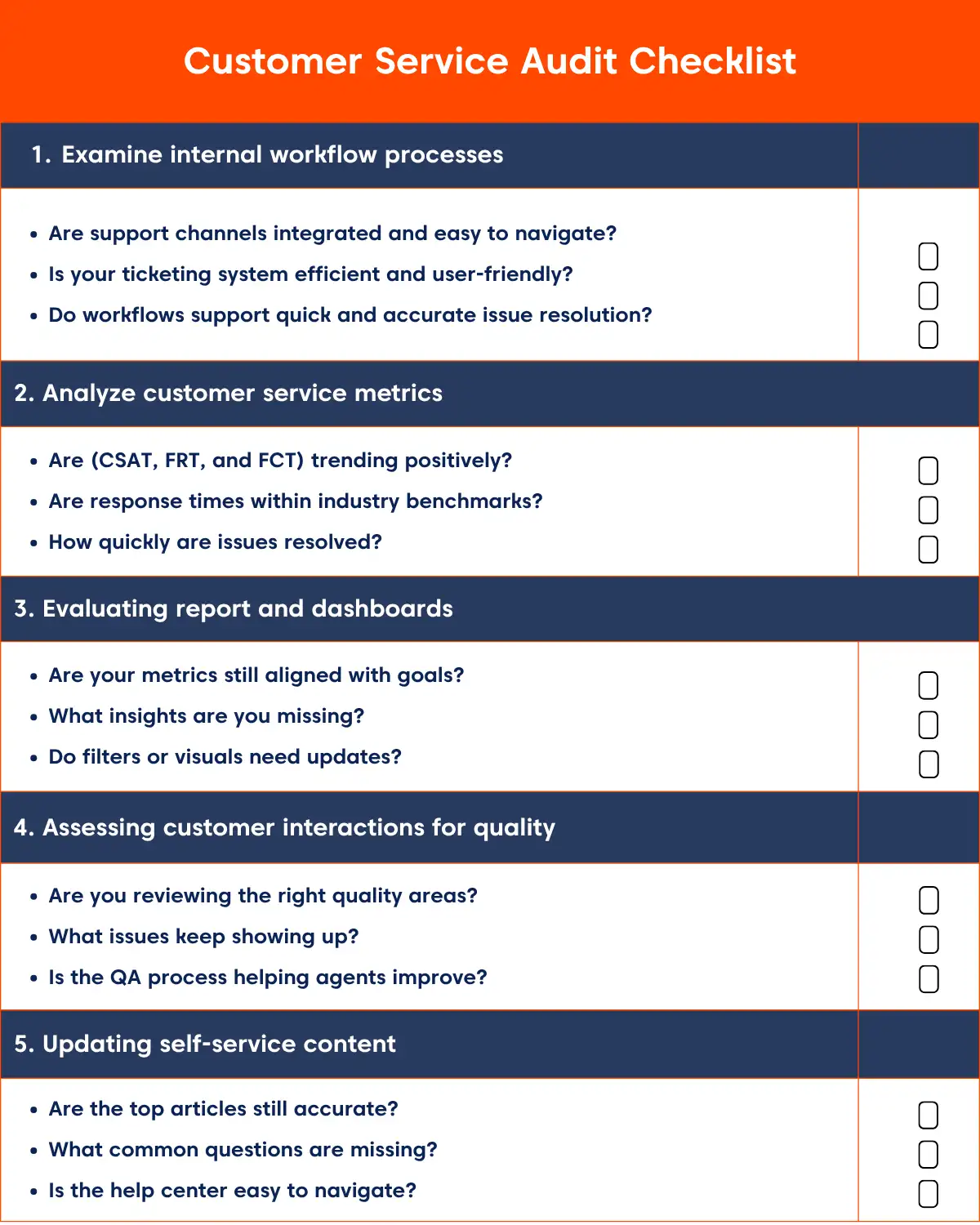
Reviewing internal workflows and tools
Customer service systems and workflows differ from one organization to another. During your service audits, your focus should be on confirming that all customer service processes, teams and tools align with both your present requirements and future goals.
Sample questions to ask on workflow processes and tools
- Are your current customer service tools still necessary, fully utilized, and running the latest versions?
- Are all automated replies, including macros, accurate and do they align with your communication standards?
- Examine your help desk workflow process and confirm – Does it still fit and favor your support structure and customer expectations?
- How does your team manage negative feedback and customer interactions? Does it lead to constructive outcomes and service improvement?
A review of internal workflows and tools keeps your support operations efficient, scalable, and aligned with customer expectations, making it essential for a successful customer service audit.
Evaluating customer service metrics
To understand team performance and identify areas for enhancing the customer experience, it’s essential to regularly assess the metrics you track, review internal quality assessments or customer service scorecards.
Sample questions on evaluating customer service metrics
- What are the key metrics you should consider for the audit? – Examples: Customer satisfaction (CSAT) score, first response time (FRT), first contact resolution (FCR), and more.
- Do they align with your organization’s strategic goals?
- Are you including individual agents, the broader team, and the entire customer service department?
Regularly evaluating customer service metrics in line with business goals ensures that performance improvements are targeted and effective, making it essential for continuous service excellence.
Analyzing reports and dashboards
Support teams rely on dashboards and reports to track performance and guide decision-making. As part of your audit, it’s important to evaluate whether these reports and dashboards are still effective, relevant, and aligned with your current goals.
Sample audit questions when tracking performance
- Dashboard metrics: Revisit the metrics currently displayed in each dashboard. Are they still aligned with your goals? Do any filters or data sources need updating?
- Reporting gaps: Reflect on the insights you’ve needed since your last audit. Were there any questions you couldn’t answer easily? Are there aspects of agent performance that remain unclear?
- Improvement opportunities: While not everything can be measured numerically, well-designed reports can highlight trends, motivate teams, and support better decision-making. Consider what new reports could add value.
Continuous auditing of your dashboards and reports provides your support team with accurate insights into smarter decisions and improved performance.
Assessing customer interactions for quality
Regularly assessing customer interactions is key to maintaining high service standards, improving training, and delivering a customer experience.
If you haven’t already, your audit is the perfect time to launch or enhance your quality assurance (QA) program. Revisit your QA scorecard to ensure it aligns with your current service goals and priorities.
Sample questions on quality of customer interactions
- Accuracy and procedure: Was the solution correct and aligned with internal guidelines?
- Empathy and tone: Did the agent communicate with care, patience, and professionalism?
- Language and clarity: Was the message well-written, clear, and grammatically correct?
- Personalization: Was the response tailored to the customer’s specific situation?
- Proactiveness: Did the agent go beyond the basics to offer extra help or prevent future issues?
Incorporating quality assessments into your audit helps ensure every customer interaction reflects your brand values, supports agent development, and drives continuous improvement in service delivery.
Updating self-service content
According to the CXM Today report, 81% of customers want more self-service options.
That makes it essential for your knowledge base and other self-service tools to be easy to navigate and filled with accurate, up-to-date information.
As part of your customer service audit, take time to evaluate the effectiveness of these resources. Here are more sample questions to consider:
Sample audit questions on self-service resources
- Are the titles straightforward and easy for users to understand? Are they meeting the SEO standards?
- Have there been product or service updates that require revisions to existing articles?
- Are there common customer questions that aren’t addressed in your help center?
- Does the layout of your knowledge base software still make sense, or could it be reorganized for better usability?
Regularly updating your self-service content ensures customers can quickly find reliable answers on their own, reducing the volume of support, and reinforcing trust in your brand.
Streamline your customer service audit process with BoldDesk
Auditing your customer service isn’t just a routine check, it’s a strategic step toward delivering exceptional support that sets your business apart.
Every business needs the right tools, centralized data, and clear visibility into agent performance, support quality, customer satisfaction, and SLA compliance.
BoldDesk empowers organizations to conduct thorough and efficient customer service audits with features like customizable workflows, seamless integrations, real-time reporting and analytics dashboards. These capabilities help you identify gaps, track progress, and make data-driven decisions that enhance service quality.
Contact us to start your audit journey with confidence. Discover how BoldDesk can make your audit process easier and help improve your customer service operations continuously.
Did you find this article interesting? We’d love to hear your thoughts or suggestions; feel free to share them in the comments below.
Related articles
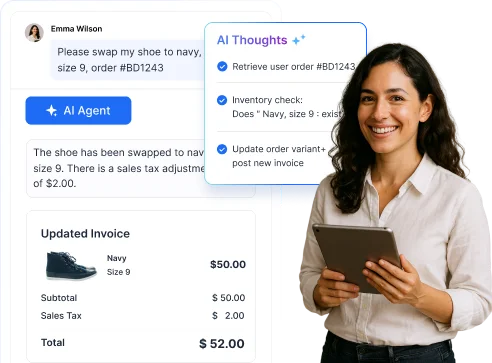


















 Email Ticketing System
Email Ticketing System Shared Inbox Software
Shared Inbox Software Multi Brand Help Desk
Multi Brand Help Desk Internal Help Desk Software
Internal Help Desk Software Trouble Ticketing Software
Trouble Ticketing Software Mobile Help Desk
Mobile Help Desk 










